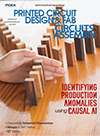News
News
Substrate Support: Dedicated vs. Reconfigurable
Published: 25 September 2008
by Clive Ashmore
One size doesn’t fit all. Here’s why.
As critical as any other input, board support technologies generally fall into two main categories: dedicated tooling plates and reconfigurable (or pin array) systems. As you likely are aware, dedicated tooling fixtures are large metal blocks that have openings machined out to accommodate the underside board topography. These tooling plates are created from the board’s CAD data and, in theory, should be an exact match to board and component dimensions. Like stencil manufacture, however, this is not always the case, and selecting a knowledgeable tooling vendor should be a big consideration when sourcing dedicated plates. Pin array systems, on the other hand, are reconfigurable tooling that can be used over and over again, with pin settings for each product run or for each board, depending on preference. Both offer varying degrees of substrate stability, but which is better and why?
Internal testing results. Like most process inputs, there isn’t a simple “one size fits all” answer for board support; the solution depends on several factors. To understand when a tooling approach is better for certain applications, our company conducted internal testing, evaluating such process variables as board thickness and SMT component types. We ran three boards of varying thicknesses (0.6, 1 and 1.6 mm) through our test process using both a pin array tooling system and a dedicated fixture plate. Each of the test vehicles was populated with standard SMT components, including a 0.4 mm QFP, a 0.5 mm CSP and 0805, 0603, 0402 and 0201 resistor packs. We wanted to evaluate the influence of a dedicated plate with vacuum against a pin array solution without vacuum, but with the ability to support under and around components.
The large capacitors were soldered onto the board’s bottom side and then a 0.4 mm CSP was assembled onto the topside directly above the large capacitors. We wanted to understand whether support directly underneath a fine-pitch component (as with the pin array system) would have an influence on print quality. Based on the data, we concluded it does indeed make a difference – sort of. What we discovered was the pin array support technology offers excellent support – even superior to dedicated tooling in some cases – until you approach boards of certain thicknesses. On the very thin (0.6 mm) board, the pin array system was not as robust as dedicated tooling. When using the reconfigurable system, the data showed a trend of lower paste volume capability on three of the QFP devices, indicating the board was not truly flat and parallel to the stencil during the print cycle.
That said, for boards densely populated on the top and bottom side, it is my opinion the pin array system is far superior to dedicated plates. Dedicated custom tooling just cannot cost-effectively be manufactured to offer the support required. I mean, imagine a very high-density board and all the very thin channels that would need to be machined on the tooling plate; it’s really not that feasible, and what you’d likely end up with is a big hole with very little support. So, anywhere a large area is unsupported by the tooling, the board will bow away from the squeegee and you’ll get inconsistent deposit volumes. And, as noted, if the tooling isn’t manufactured properly (which isn’t that uncommon), then the print also will be substandard.
The reconfigurable pin array system, however, raises to deliver support underneath each bottom side device, thereby offering optimum support for the topside print. It also bears mentioning that in high-mix environments with a lot of product changeover, compliant pin array tooling provides a fast, cost-effective solution. Pins can be reset in seconds and a one-time investment in the system can be used to support numerous products, as opposed to dedicated tooling, which has to be manufactured for each specific assembly.
I’m not suggesting replacing all dedicated fixture plates with pin array systems. In fact, as mentioned, there are applications where dedicated tooling is the answer. This is the case with not only the thinner substrates, but also for applications that have few components on the bottom side (i.e., there is very robust support for the topside print) or high-volume environments that are primarily manufacturing a single product). Most manufacturing issues lack a “one size fits all” solution. The same holds for tooling. Provided you understand the limits and advantages of each system, you can make the appropriate choice for your manufacturing requirements.
Clive Ashmore is global applied process engineering manager at DEK (dek.com); cashmore@dek.com. His column appears bimonthly.
Press Releases
- Trilogy-NET Adds Second Vapor Phase Reflow System to Expand High-Precision Manufacturing
- Federal Electronics Invests in HydroJet Inline Cleaning Technology at Hermosillo Facility
- Seika Machinery to Host Webinar on Wireless Strain Measurement for PCB Testing
- NEPCON ASIA 2025: Innovating Smart Manufacturing Ecosystems and Bridging Global Opportunities







